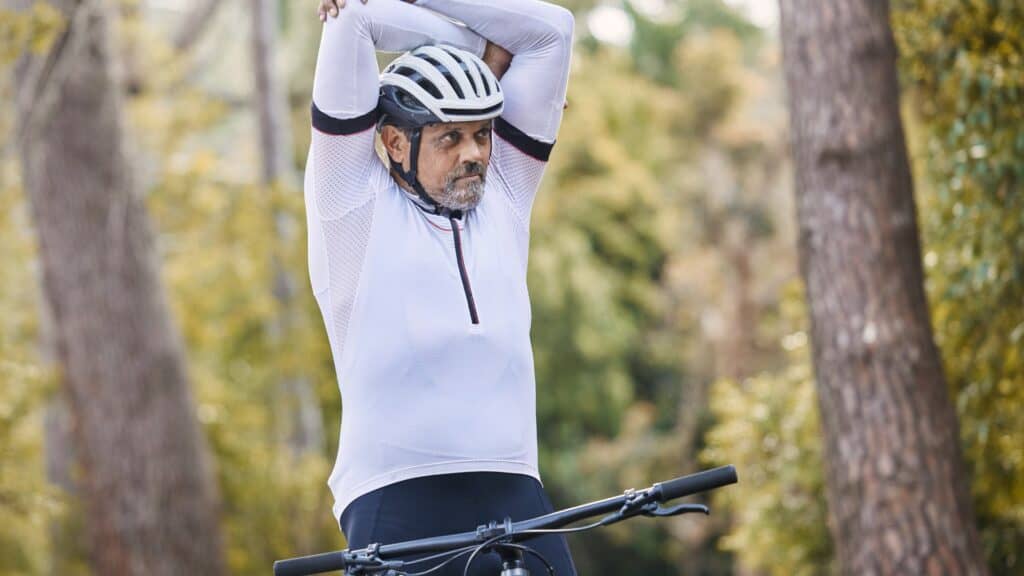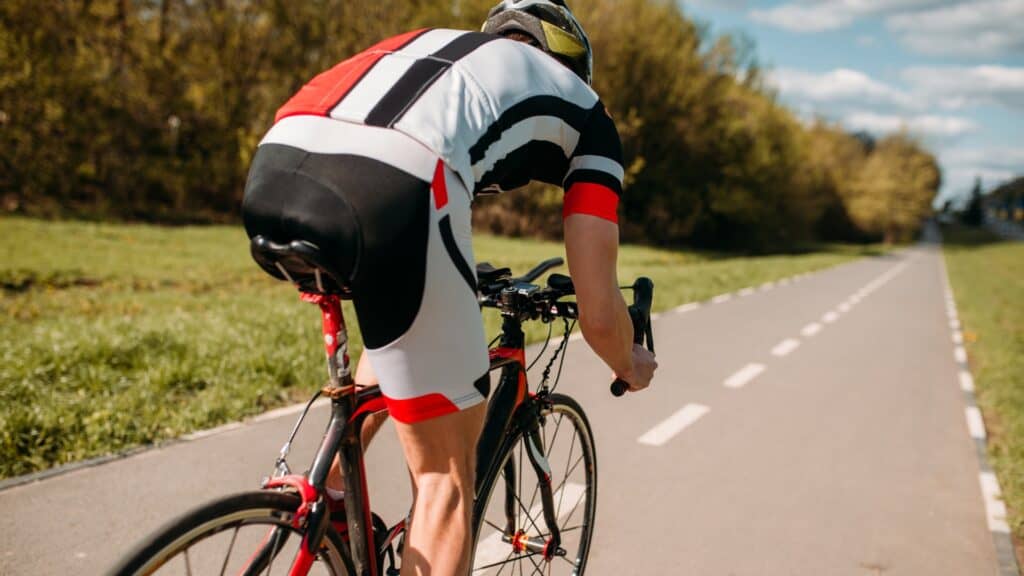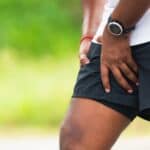In the fast-paced world of cycling, every rider seeks the perfect harmony between comfort, performance, and injury prevention.
In this article, we delve into the multifaceted realm of stretching – a cornerstone practice with the potential to enhance cycling prowess and well-being.
We also discuss the nuanced art of stretching for cyclists, exploring its importance, key areas for focus, optimal timing and techniques, and supplementary strategies for peak performance.
Join us as we navigate the winding roads of cycling wellness, uncovering the secrets to pedal power, pain-free rides, and lasting cycling satisfaction.

To Stretch or Not to Stretch When Cycling
Importance of Stretching for Cyclists
Stretching plays a significant role in maintaining overall flexibility, which is vital not only for cycling but also for daily activities. Proper stretching helps prevent injuries and can improve your cycling performance.
Key Areas to Stretch for Cyclists
- Lower Back: Stretching the lower back is essential, as it often experiences strain during cycling.
- Glute Muscles: Keeping the glutes flexible helps prevent lower back issues and improves cycling efficiency.
- Hamstrings and Quads: These muscles are heavily used during cycling. Stretching them individually is crucial for preventing tightness and injuries.
- Hip Flexors: Often neglected, tight hip flexors can lead to knee pain. Stretching them is vital, especially for those who sit for extended periods.
- Calves: Stretching the calves helps maintain lower leg flexibility and reduces the risk of cramping.
- Shoulders and Neck: Cyclists put pressure on their upper bodies, so stretching the shoulders and neck is important to prevent stiffness and discomfort.
When and How to Stretch
- Dynamic Stretching Before Exercise:
- Pre-Ride Warm-Up: Start with a light exercise to increase blood flow and core temperature, making muscles more pliable.
- Dynamic Stretches: These involve movement and help prepare the muscles and joints for the ride. Examples include leg swings, arm circles, and torso twists.
- Static Stretching After Exercise:
- Post-Ride Routine: After your ride, when your muscles are warm, perform static stretches.
- Static Stretches: These involve holding a stretch for a prolonged period (30-60 seconds) to increase flexibility. Examples include hamstring stretches, quad stretches, and calf stretches.
Stretching Frequency and Duration
- Twice a Day: Aim to stretch twice a day for overall flexibility and injury prevention.
- Duration: Hold each stretch for 30-60 seconds per side or limb and repeat the stretch twice.
- Consistency: Regular stretching will help maintain and improve flexibility, enhancing your cycling performance.
Additional Recommendations
- Pilates and Yoga: Incorporating Pilates or yoga into your routine can significantly benefit your flexibility and strength, contributing to better cycling performance.
- Personal Experience: We advocate for the benefits of incorporating flexibility training like yoga and Pilates into your exercise routine.
Stretching is a critical component of a cyclist’s training regimen. By incorporating dynamic stretches before your ride and static stretches afterwards, you can enhance your performance, prevent injuries, and maintain overall flexibility.

Saddle Sores: Prevent & Treat Cycling’s Pain in the Butt
How to Prevent Saddle Sores
- Time on the Saddle
- Spend a significant amount of time on the saddle to allow your sit bones and body to adapt.
- Proper Bike Fit
- Ensure your bike is set up correctly to avoid unnecessary movement that can cause friction and lead to saddle sores.
- Quality Equipment
- Use a good saddle and quality cycling shorts for comfort and support.
- Comfort will improve over time as the area toughens up.
- Hygiene
- Always wear clean shorts while cycling.
- Use antibacterial chamois cream to reduce friction and chafing. Experiment with different brands to find the one that works best for you.
- After a ride, avoid staying in sweaty, dirty cycling gear. Shower immediately, clean the area, and put on dry clothes to maintain hygiene and dryness.
How to Treat Saddle Sores Effectively
- Rest
- For minor saddle sores, rest is usually sufficient. Stay off the bike for a few days to allow the area to heal.
- Antibacterial Ointments
- Apply antibacterial ointments to help with minor rashes or sores.
- Avoid Squeezing
- Do not pop or squeeze ingrown hairs or blisters as this can lead to infections.
- Seek Medical Help
- For severe cases, visit a doctor for proper treatment. They can dress the wound and provide medical advice to ensure it heals correctly.

Saddle Sores: Prevent & Treat Cycling’s Pain in the Butt
- Importance of Proper Bike Setup
- Spend a significant amount of time on the saddle to allow your sit bones and body to adapt.
- Core Strength and Upper Body Conditioning
- Strengthening your core and back muscles is essential. A strong core supports proper posture and reduces strain on the lower back. Additionally, maintaining upper body strength is important as it supports the position on the bike, particularly the hands and shoulders.
- Role of Flexibility
- Flexibility in the hamstrings, glutes, and lower back is critical. Often, inflexibility in these areas is the underlying cause of lower back pain rather than the bike setup itself. Ensuring regular flexibility exercises can help alleviate this pain.
- Recommendation of Pilates
- Pilates is recommended for its benefits in core strength and flexibility. Participating in Pilates classes can significantly improve core stability and overall flexibility, which are vital for a pain-free cycling experience.
- Implementing a Core Strength Program
- Consistently working on a core strength program is advised. This should include exercises that target the core, back, and upper body to build a solid foundation for cycling.

Is Power All That It Is Cracked Up to Be When Cycling?
- Accessibility and Cost
- Power meters are becoming more affordable and accessible, although they remain a significant investment for many cyclists.
- Precision and Consistency
- Training with power offers precise and straightforward metrics. Unlike heart rate, which can be influenced by various factors, power output provides consistent and objective data. Cyclists can train and race at specific wattages, making it easier to monitor and adjust intensity accurately.
- Benefits for Monitoring and Racing
- Power meters help in both training and racing by providing real-time data on effort and performance. They enable cyclists to understand their capabilities and manage their energy more effectively over different durations and intensities.
- Data Analysis and Coaching
- Power data can be highly beneficial when analyzed correctly. Working with a coach to interpret this data ensures that cyclists gain the maximum benefit from their power meters. Coaches can provide insights and adjustments based on the data, leading to more effective training plans.
- Risk of Information Overload
- Cyclists should be cautious of information overload. The abundance of data from power meters and other gadgets can be overwhelming. It’s crucial to use this data effectively and not get bogged down by unnecessary details. This is where the guidance of a coach can be invaluable.
- Indoor Training Options
- There are also indoor trainers available that measure power, providing an alternative for those who may not want to invest in a power meter for their bike.
Summary:
To determine if a power meter is right for you, consider the following:
- Assess the Cost vs. Benefit: While power meters provide valuable data, ensure that the investment is justified by the benefits you receive.
- Focus on Precision: Power meters offer more precise and consistent metrics compared to heart rate monitors.
- Leverage Coaching: Utilize a coach to help analyze the data and integrate it into your training effectively.
- Avoid Information Overload: Be mindful of not getting overwhelmed by data. Focus on key metrics that aid your training goals.
- Consider Indoor Trainers: Explore indoor training options that include power measurement as a cost-effective alternative.

Is Power All That It Is Cracked Up to Be When Cycling?
Cycling is a fantastic way to stay fit and enjoy the outdoors, but it’s not without its challenges.
Many cyclists experience numbness and pain during their rides, particularly in their hands, neck, and shoulders. These discomforts can detract from the enjoyment of cycling and even lead to long-term issues if not addressed properly. However, with the right adjustments and techniques, you can alleviate these problems and enhance your cycling experience.
Here are some practical tips to help you deal with numbness and pain while cycling:
- Check Your Bike Setup
- Proper Fit: A well-fitted bike is essential for comfort and performance. Ensure that your saddle height, handlebar reach, and drop are adjusted to suit your body proportions.
- Handlebar Reach and Drop: Avoid excessive reach or drop from your saddle to handlebars, as this can put undue pressure on your hands and lead to numbness.
- Contact Points: Invest in quality grips and bar tape that provide adequate cushioning and support for your hands. Gel padding can also help alleviate pressure points.
- Equipment Adjustments
- Grips and Bar Tape: Choose grips and bar tape that are comfortable and provide sufficient padding to reduce vibrations and impact.
- Padding: Consider using gel pads or padded gloves to cushion your hands and absorb shocks from rough terrain.
- Relaxation and Technique
- Relax on the Bike: Practice keeping a relaxed grip on the handlebars to prevent unnecessary tension in your hands and arms. Focus on maintaining a neutral posture to reduce strain on your neck and shoulders.
- Posture: Ensure that your bike setup allows for a comfortable riding position without requiring you to crane your neck upwards. A slightly raised handlebar position may help alleviate neck and shoulder discomfort.
- Strength and Conditioning
- Core Strength: Incorporate core-strengthening exercises into your routine to improve stability and support your upper body while cycling. Strengthening your back and shoulder muscles can also help prevent fatigue and discomfort.
- Professional Bike Fit
- Importance of a Proper Fit: Consider investing in a professional bike fitting session to optimize your bike setup and address any biomechanical issues. A trained fitter can assess your riding position and make necessary adjustments to enhance comfort and performance.
Numbness and pain while cycling are common issues that can be mitigated with the right approach. By ensuring a proper bike setup, choosing appropriate equipment, practising relaxation techniques, and incorporating strength training, you can minimize discomfort and enjoy more pleasant rides. Remember, it’s essential to listen to your body and make adjustments as needed to prevent long-term injuries.



Comments are closed.